Panzer V Panther Tank Ausf. A
This German WW2 Panther Ausf A Medium Tank Sd.Kfz.171 can be found at the German Tank Museum - Deutsches Panzermuseum in Munster, Germany. This Panther tank was produced during WW2.
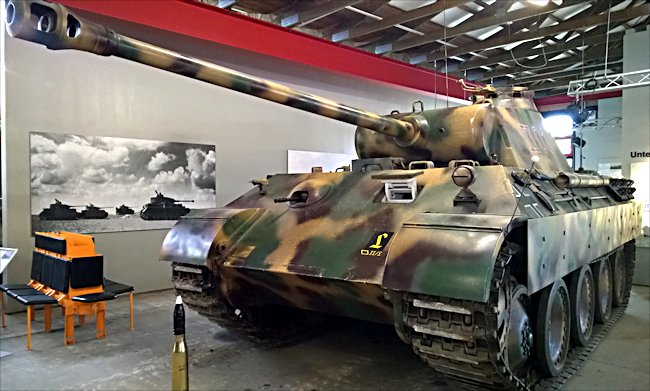
German Panzerkampfwagen V Panther Tank Ausf. A
This Panther Ausf. A Befehlspanzer tank was bought by Sweden in 1948 for trial purposes. It was given back to the Panzerlehrbrigade at Munster in 1960. Some years later it was handed over to the Panzertruppenschule. In the 1980's the commander of the Panzertruppenschule initiated a total restoration. Also the original HL 230 engine was overhauled by MTU at Friedrichshafen. After some problems with the HL 230 engine and the lack of spare parts, the engine was replaced by a modern MTU Diesel. So the sound of this tank, while being moved, is not original. However it is in running condition.
Two Panther Tanks cover the Hochwald Ridge retreat
The German town of Xanten was on the Rhine River. The Canadians had been ordered to advance and capture the river bridge intact. The Allies needed a way cross the mighty Rhine river to be able to advance into Central Germany and then on to berlin. The Germans had set up a number of defensive locations to slow down the Allied advance that they knew was coming. On the 27th February 1945 the Allied Operation Blockbuster started. With the aim of capturing the bridge.
The forested Hochwald Ridge was the last defensive line before the town of Xanten. It was cut in two by a valley called the Hochwald Gap. This is where the main thrust of the attack went. The Sherman tanks of the 2nd Canadian Armoured Brigade had suffered a number of losses during the attack. It was looking like stalemate. The Germans, although out-numbered, had chosen the locations where to ambush the advancing Canadians with care. The Sherman tanks were just picked off one by one. The defenders were very hard to knock out.
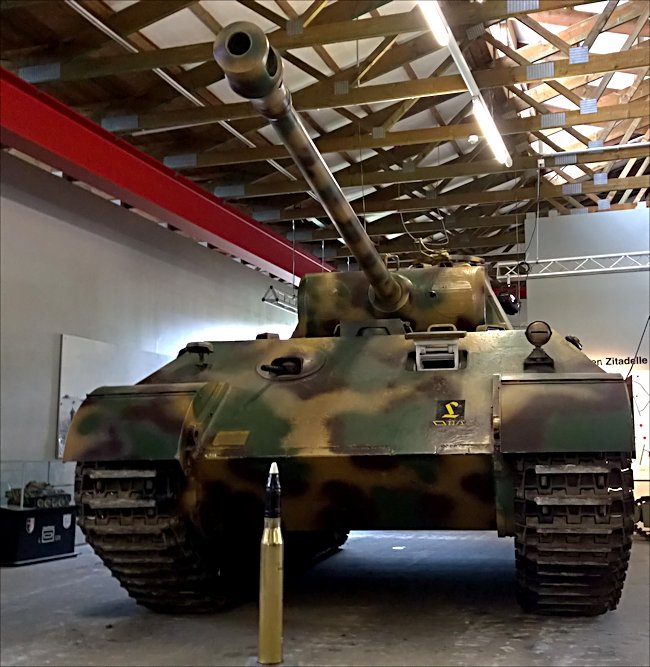
This was the size of shell fired from the Panther Tank
The short barrelled 75mm guns on the standard Sherman tanks could not knock out a Panther or Tiger tanks front on. Their shells bounced off the 80mm frontal sloping armour of the Panther and the heavy 100mm armour of the Tiger. Sherman tank crews normally only had a slim chance of success if they could get around the flanks of these tanks at close range and fire at a weak spot in their side or rear armour. This task was practically impossible in the terrain they were fighting in.
The sun came out and cleared away the low lying grey wintery February cloud. RAF rocket firing Typhoon ground attack bombers came to the rescue. If a German panzer was hit by one of these destructive rockets they just broke up into pieces. On 4th March 1945 after days of heavy fighting, remaining German troops and tanks that escaped the rocket attacks withdraw to the River Rhine town of Xanten.
Lt. Danny Mcleod of the South Albert Regiment was there, "This was an art the German had. We should have basically learnt by their example. They have a habit of putting on a tremendous show of firepower, so that the last thing you can think of is that they are withdrawing. That’s what they do. They leave people in position who are then very aggressive with their weapons, continually firing."

This was the size of shell fired from the Panther Tank
Lt. Ed Haddon, tank commander in the Canadian Sherbrooke Fusiliers remembers, "They left two panzer V Panther tanks to cover the retreat at the Hochwald Gap. There was a small ridge and they were on the other side. They would fire on any tank that went over the top. The Shermans were kept on the other side in a turret down position. The main body of the tank was not exposed. It was hidden by the rise in the ground."
"The panther tank could kill you. They can put a shell into the front of a Sherman and it will come out the back and they can do that three mile away. We had a 17pdr Sherman Firefly. The tank commander Ed, same name as me, believed he could knock both of them out if he did it right. He gave his gunner control and the gunner popped the breach on his gun. The Firefly slowly crept up the slope. He looked through his gun barrel until he got crest clearance and gets his sights on the nearest Panther tank."
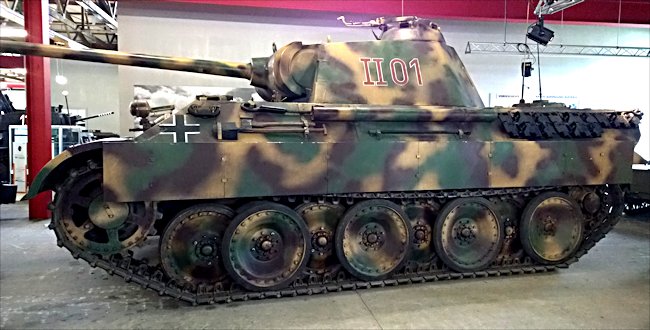
Even the turret and side armour was sloped on the Panther Tank.
"That first German tank was backing up along a narrow road but keeping his heavy sloping frontal armour facing towards us. He accidentally backs the rear corner of the tank off the road and into a ditch. This had the effect of tipping up the front of the tank exposing the thinner 30mm armour plate underneath the tank. Ed’s gunner aimed right in the middle of this weaker plate armour. He hit it and then put in another round in the same spot. The Panther caught fire and brewed up. I did not see if any crew got out or not."
The other Panther tank was now driving away as fast as it could go. The back of the Panther tank’s armour is not thick. Again only 30mm. Ed’s tank fired. It missed the rear of the tank, ricocheted of the back engine plate and took the tank commander’s head off. The tank stopped and all the crew jumped out. That was the last remaining obstacle in the Hochwald Gap because of two silly fatal tactical mistakes by the crews of the Panther tanks. The Canadians pressed on to the bridge over the River Rhine at Xanten, their final objective in operation Blockbuster.
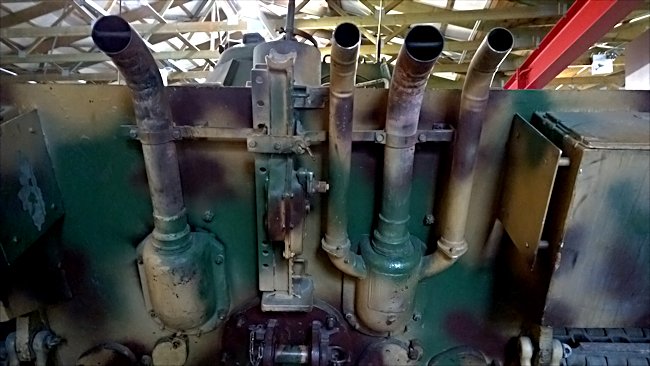
The jack was bolted between the Panzer V Panther Tank's exhaust pipes.
The 85% of the town was destroyed by heavy allied bombing raids day and night to crush the German’s resistance. On 7th march 1945, a month after the fighting in the German Rhineland began, Canadian Sherman tanks rolled into Xanten. The bridge was captured and Germany surrendered two months later. This is one of the forgotten battles. One of the reasons is that Hollywood has not made a film about the action unlike the capture of the Bridge at Remagen, which was the first bridge to be captured. There was a great loss of life on both sides. The Germans lose 40,000 killed or wounded. The fighting in the Rhineland for the Canadians was the bloodiest operation of the war. They had 5,300 dead and wounded in 30 days of fighting. This rate of attrition was more than D-day and the battle for Normandy.
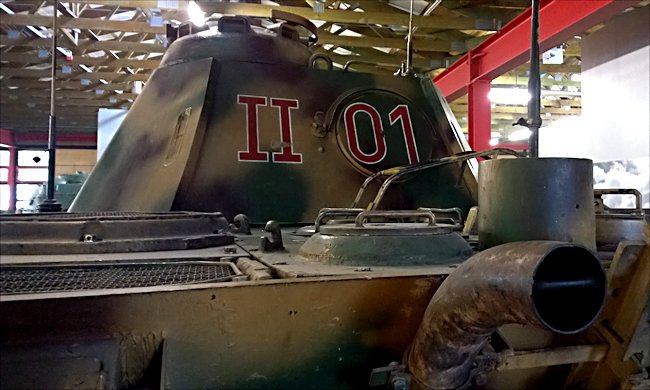
There was a large escape hatch at the back of the Panther Tank.
Where did the Allies first encounter a Panther tank?
In Italy May 1944 the 1st Canadian Armoured Divisions were advancing through the German defensive positions called the Hitler Line. They had gone past the town of Aquino, crossed the Melfa River and heading north westwards up the main road towards Rome.
Canadian Lance Corporal Robert Greene, Lord Strathcona’s Horse, was in one of the advancing M4 Sherman tanks. He recalls, "The Germans were withdrawing. We came up to the Torrice crossroads chasing them. They made a stand there. It was the first time we had come across them on battle. They knocked out a number of our tanks."
"The Sherman tank I had been in fifteen days before was hit in the turret. Everyone in the turret, which would have been me, was killed. One of our tanks was hit in the side. The shell went right through that outer plate, into the tank, out the other side and knocked off the external plate that was welded there. We never found that afterwards."
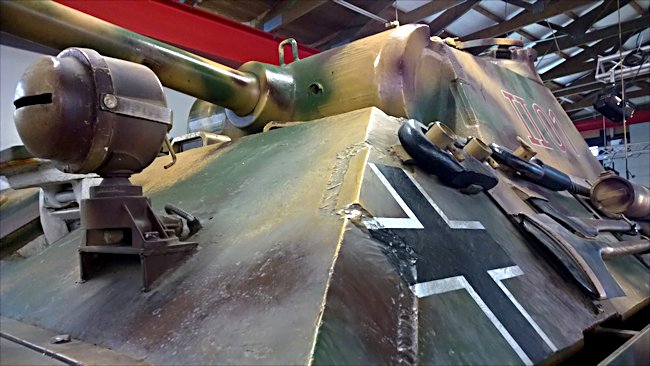
The Panther Tank's sloping frontal armour was dovetailed and welded for extra strength.
Jimmy Barr’s tank came down the hill and as they were by the crossroads was this German Panther tank. They immediately engaged it. Fifteen armoured piecing AP shells at point blank range, 100 yards away, just bounced off. It just scared the dickens out of the gunner to fire 15 AP shells at this thing and watch them all bounce off the front. I was told this was the first time the allies had encountered the New Panther tank in battle.
One of the Sherman shells landed between the turret and the hull. It had damaged the traverse mechanism which meant the gunner could not move the gun at all, otherwise they would have been dead all of them. Then they hit upon the idea of putting a high explosive shell on delay fuse into the bogies: that is the wheels on the side between the tracks. That worked. That knocked out that tank.
The Panzer V Panther tank had 80mm slopping front amour which gave it the equivalent of 145mm armour protection which no Sherman tank at that stage of the war, could penetrate.
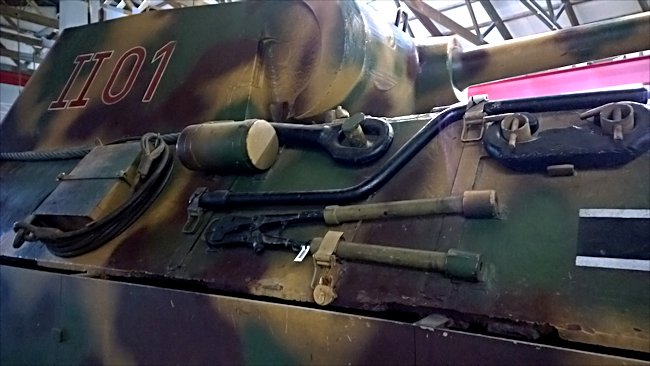
Tools were carried on the outside of the Panther Tank
Bazookas fail to kill German Panther tanks
During the Battle of the Bulge in December 1944, Panther tanks from the 1st SS-Panzer-Division were advancing via the road called Rue Haute alongside the River Ourthe in the Belgium village of Hotton, looking for a way across. On the other side of the river American troops started firing at the tanks. The Panzer tanks seemed impervious to 40 mm anti-tank shells and bazooka rockets fired at their sides. A bazooka could knock out a Panther tank but it had to be fired from close range. It just did not have enough energy to penetrate the armour of the Panther tank at long distance. The Germans returned fire and destroyed a Sherman tank and an ammunition truck before being halted by anti-tank mines that had been laid across the street.
Another Panther was destroyed as it went through the gardens behind the houses that lined the same road in an effort to avoid the anti-tank mines. Unfortunately, the American M10 tank destroyer was laying in wait. It let the Panther tank drive past before opening fire. It's shell smashed into the rear of the turret. It was only 70 m away from the bridge over the River Ourthe. The Panther tank commander, Leutnant Kohn, lost an eye. But managed to escape with another member of the crew. Two other crew members were trapped inside the burning Panzer V. A third was shot.
Where can I find other preserved Panther Tanks?
- Panther Ausf. A - Wheatcroft Collection, England
- Panther Ausf. A - Befehlspanzer Munster Germany (running condition)
- Panther Ausf. A - (n° 224) Auto + Technik Museum, Sinsheim, Germany
- Panther Ausf. A - (n° 243) Auto + Technik Museum, Sinsheim, Germany
- Panther Ausf. A - (n° 413) Private Collection, Germany
- Panther Ausf. A - (n° 256) Saumur Tank Museum France
- Panther Ausf. A - (n° 211) Saumur Tank Museum France (running condition)
- Panther Ausf. A - Omaha Overlord Museum, Colleville-sur-Mer, France
- Panther Ausf. A - 501/503e RCC Mourmelon-le-Grand France
- Panther Ausf. A - (n° 201) Royal Jordanian Tank Museum, Jordan
- Panther Ausf. A - Australian Armour and Artillery Museum, Cairns, Queensland.
- Panther Ausf. A - National Armor and Cavalry Museum, Fort Benning, GA,USA
- Panther Ausf. A - U.S. Army Ordnance Museum, Fort Lee, VA, USA
- Panther Ausf. A - The Collings Foundation, Stow, MA, USA (running condition)
- Panther Ausf. A - Canadian War Museum (CWM) in Ottawa Canada
- Panther Ausf. A or D Panzermuseum, Thun, Switzerland
- Panther Ausf. D - Breda Netherlands
- Panther Ausf. G - Bovington Tank Museum England (British Built)
- Panther Ausf. G - Wehrtechnische Dienststelle, Trier, Germany (British Built)
- Panther Ausf. G - Privately owned now confiscated by police, Germany (British Built)
- Panther Ausf. G - National War and Resistance Museum, Overloon Netherlands
- Panther Ausf. G - Houffalize Belgium
- Panther Ausf. G - Grandmenil Belgium – engine, gearbox and transmission are present
- Panther Ausf. G - Celles Belgium
- Panther Ausf. G - (n° 332) Saumur Tank Museum France
- Panther Ausf. G - Kubinka Tank Museum Russia (running condition)
- Panther Ausf. G - U.S. Army Ordnance Museum, Fort Lee, VA, USA
- Panther Ausf. G - 2x National Armor and Cavalry Museum, Fort Benning, GA, USA
- Source - Pierre-Oliver Buan - http://the.shadock.free.fr/Surviving_Panzers.html
WW2 tank books

